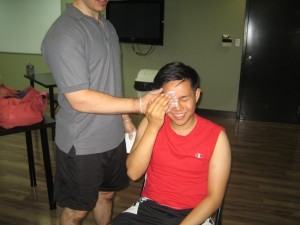Eye emergencies are eye injuries wherein eyesight is at risk,

especially if left untreated, that can occur on the eyelid or eyeball itself. The eye is a sensitive organ that is easily damaged and any of these damages can lead to partial loss of vision, and in extreme cases, blindness. Some common eye emergencies include scratches, cuts, foreign objects in the eye, burns, chemical exposure and blunt injuries.
Signs and Symptoms of Eye Emergencies
Signs and symptoms of eye emergencies will depend on the type of injury, however, the presence of the following signs and symptoms are the commonest implications of an eye emergency:
- Headache
- Itchy eyes
- Eye pain
- Stinging or burning in the eye
- Unequal pupil sizes
- Bulging eye
- One eye is not moving like the other
- Redness (bloodshot appearance of eyes)
- Bruising
- Bleeding or discharge from or around the eye
- Sensation of an object in the eye
- Photosensitivity
- Decreased vision
- Double vision
- Loss of vision
What Not to Do in Eye Emergencies
The best thing to do in all cases of eye emergencies is to call for emergency medical services. It is necessary to take prompt action to avoid further damage and First Aid will depend on the type injury sustained. For more instructions on eye emergencies, enroll in First Aid Courses with workplace approved Training. It is important to NOT do the following in cases of eye emergencies as it may aggravate the condition and cause serious complications. Do NOT:
- Put any sort of medication or ointments in the eye
- Rub or apply pressure to the eye
- Attempt to remove any foreign object that is stuck in any part of the eye
- Use tweezers or any tools in the eye – it is only advised to use cotton swabs on the eyelids
Prevention of Eye Emergencies
Prevention is always better than cure. The following can help decrease chances of sustaining an eye injury:
- When using power tools or engaging in high-risk sporting events, wear protective eyewear
- Keep sharp objects such as scissors and knives away from children. Pencils have also caused damage to the eyes
- Do not allow young children to play with projectile toys, such as pellet guns and darts, especially in there is no parental supervision
- Childproof home by removing or cushioning sharp edges
- Keep heated hair appliances away from the eyes
- Always keep distance from fireworks, especially amateur shows
Eye emergencies can easily lead to serious complications, thus medical help is always necessary. Although some injuries may seem like a simple scratch, they can lead to vision loss. To learn how to recognize and manage eye emergencies, enroll in First Aid Courses with workplace approved Training.